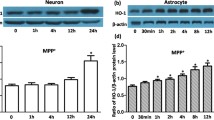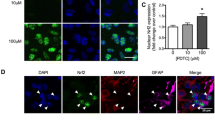Abstract
The mechanisms responsible for the pathological deposition of brain iron in Parkinson’s disease, Alzheimer’s disease and other human neurodegenerative disorders remain poorly understood. In rat primary astrocyte cultures, we demonstrated that dopamine, cysteamine, H2O2 and menadione rapidly induce heme oxygenase-1 (HO-1) expression (mRNA and protein) followed by sequestration of non-transferrin-derived55Fe by the mitochondrial compartment. The effects of dopamine on HO-1 expression were inhibited by ascorbate implicating a free radical mechanism of action. Dopamine-induced mitochondrial iron trapping was abrogated by administration of the heme oxygenase inhibitors, tin mesoporphyrin (SnMP) or dexamethasone (DEX) indicating that HO-1 up-regulation is necessary for subsequent mitochondrial iron deposition in these cells. Over-expression of the human HO-1 gene in cultured rat astroglia by transient transfection also stimulated mitochondrial55Fe deposition, an effect that was again preventible by SnMP or DEX administration. We hypothesize that free ferrous iron and carbon monoxide generated by HO-1-mediated heme degradation promote mitochondrial membrane injury and the deposition of redox-active iron within this organelle. We have shown that the percentages of GFAP-positive astrocytes that co-express HO-1 in Parkinson-affected substantia nigra and Alzheimer-diseased hippocampus are significantly increased relative to age-matched controls. Stress-induced up-regulation of HO-1 in astroglia may be responsible for the abnormal patterns of brain iron deposition and mitochondrial insufficiency documented in various human neurodegenerative disorders.
Similar content being viewed by others
References
Applegate, L.A., Luscher, P. and Tyrrell, R.M. (1991) Induction of heme oxygenase: a general response to oxidant stress in cultured mammalian cells.Cancer Res. 51, 974–978.
Chopra, VS., Chalifour, L.E. and Schipper, H.M. (1995) Differential effects of cysteamine on heat shock protein induction and cytoplasmic granulation in astrocytes and glioma cells.Mol. Brain Res. 31, 173–184.
Connor, J.R., Menzies, S.L., St. Martin, S.M. and Mufson, E.J. (1992) A histochemical study of iron, transferrin, and ferritin in Alzheimer’s diseased brains.J. Neurosci. Res. 31, 75–83.
Di Monte, D. (1998) Parkinson’s disease. In: Schipper, H.M. (Ed.),Astrocytes in Brain Aging and Neurodegeneration (Austin, TX: R.G. Landes Co.), pp. 111–126.
Di Monte, D.A., Schipper, H.M., Hetts, S. and Langston, J.W. (1995) Iron-mediated bioactivation of 1-methyl-4-phenyl-1,2,3,6-tetrahydropyridine (MPTP) in glial cultures.Glia 15, 203–206.
Dore, S., Takahashi, M., Ferris, C.D., Hester, L.D., Guastella, D. and Snyder, S.H. (1999) Bilirubin, formed by activation of heme oxygenase-2, protects neurons against oxidative stress injury.Proc. Natl. Acad. Sci. USA 96, 2445–2450.
Dwyer, B.E., Nishimura, R.N., de Vellis, J. and Yoshida, T. (1992) Heme oxygenase is a heat shock protein and PEST protein in rat astroglial cells.Glia 5, 300–305.
Dyrks, T., Weidemann, A., Multhaup, G.et al. (1988) Identification, transmembrane orientation and biogenesis of the amyloid A4 precursor of Alzheimer’s disease.EMBO J. 7, 949–957.
Ewing, J.F., Haber, S.N. and Maines, M.D. (1992) Normal and heat-induced patterns of expression of heme oxygenase-1 (HSP32) in rat brain: hyperthermia causes rapid induction of mRNA and protein.J. Neuwchem. 58, 1140–1149.
Ewing, J.F. and Maines, M.D. (1991) Rapid induction of heme oxygenase 1 mRNA and protein by hyperthermia in rat brain: heme oxygenase 2 is not a heat shock protein.Proc. Natl. Acad. Sci. USA 88, 5364–5368.
Faucheux, B.A., Hirsch, E.C., Villares, T., Selimi, E, Mouatt-Prigent, A., Javoy-Agid, F, Hauw, J.J. and Agid, Y. (1993) Distribution of125I-ferrotransferrin binding sites in the mesencephalon of control subjects and patients with Parkinson’s disease.J. Neurochem. 60, 2338–2341.
Frankel, D. and Schipper, H.M. (1997) Does astroglial senescence facilitate oxidative neuronal injury?Soc. Neurosci. 23, 1371 (abstract).
Gelman, B.B. (1995) Iron in CNS disease.J. Neuropathol. Exp. Neurol. 54, 477–486.
Janetzky, B., Reichman, H, Youdim, M.B.N,et al. (1997) Iron and oxidative damage in neurodegenerative diseases. In: Beal, M.F., Howell, N. and Bodis-Walker, I. (Eds.),Mitochondria and Free Radicals in Neurodegenerative Diseases (Wiley-Liss), Vol. 20, 407–421.
Jellinger, P., Paulus, W., Grundke-Iqbal, I.et al. (1990) Brain iron and ferritin in Parkinson’s and Alzheimer’s diseases.J. Neural Transm. Park. Dis. Dement. Sect. 2, 327–340.
Jenner, P. (1992) What process causes nigral cell death in Parkinson’s disease. In: Cederbaum, J.M. and Gancher, S.T. (Eds.),Neurological Clinics, Part 2: Parkinson’s Disease. (Philadelphia: Saunders Co.), pp. 387–403.
Kalaria, R.N., Sromek, S.M., Grahovac, I. and Harik, S.I. (1992) Transferrin receptors of rat and human brain and cerebral microvessels and their status in Alzheimer’s disease.Brain Res. 585, 87–93.
Keyse, S.M. and Tyrell, R.M. (1987) Both near ultraviolet radiation and the oxidizing agent hydrogen peroxide induce a 32-kDa stress protein in normal human skin fibroblasts.J. Biol. Chem. 262, 14821–14825.
Keyse, S.M. and Tyrell, R.M. (1989) Heme oxygenase is the major 32-kDa stress protein induced in human skin fibroblasts by UVA radiation, hydrogen peroxide, and sodium arsenite.Proc. Natl. Acad. Sci. USA 86, 99–103.
Klausner, R.D., Rouault, T.A. and Harford, J.B. (1993) Regulating the fate of mRNA: the control of cellular iron metabolism.Cell 72, 19–28.
Kontos, H., Wei, W, Ellis, E., Jenkins, L., Povishock, J., Rowe, G. and Hess, M. (1985) Appearance of superoxide anion radical in cerebral extracellular space during increased prostaglandin synthesis in cats.Circ. Res. 57, 142.
Maines, M.D. and Kappas, A. (1974) Cobalt induction of hepatic heme oxygenase; with evidence that cytochrome P-450 is not essential for this enzyme activity.Proc. Natl. Acad. Sci. USA 71, 4293–4297.
Manganaro, R, Chopra, VS., Mydlarski, M.B., Bernatchez, G. and Schipper, H.M. (1995) Redox perturbations in cysteamine-stressed astroglia: implications for inclusion formation and gliosis in the aging brain.Free Rad. Biol. Med. 19, 823–835.
Mash, D.C., Pablo, J., Buck, B.E., Sanchez-Ramos, J. and Weiner, W.J. (1991) Distribution and number of transferrin receptors in Parkinson’s disease and in MPTP-treated mice.Exp. Neurol. 114, 73–81.
Mattson, M.P. (1997) Cellular actions of ß-amyloid precursor protein and its soluble and fibrillogenic derivatives.Physiol. Rev. 77, 1081–1132.
Metodiewa, D., Reszka, K. and Dunford, H. (1989) Evidence for a peroxidatic oxidation of norepinephrine, a catecholamine, by lactoperoxidase.Biochem. Biophys. Res. Commun. 160, 1183–1188.
Morris, C.M. and Edwardson, J.A. (1994) Iron histochemistry of the substantia nigra in Parkinson’s disease.Neurodegen-eration 3, 277–282.
Morris, CM., Kerwin, J.M. and Edwarsan, J.A. (1994) Non-haem iron histochemistry of the normal and Alzheimer’s disease hippocampus.Neurodegeneration 3, 267–275.
Mydlarski, M.B., Brawer, J.R. and Schipper, H.M. (1998) The peroxidase-positive subcortical glial system. In: Schipper, H.M. (Ed.),Astrocytes in Brain Aging and Neurodegeneration (Austin, TX: R.G. Landes Co.), pp. 191–206.
Mydlarski, M.B., Liberman, A. and Schipper, H.M. (1995) Estrogen induction of glial heat shock proteins: implications for hypothalamic aging.Neurobiol. Aging 16, 977–981.
Mydlarski, M.B. and Schipper, H.M. (1998) Astrocyte granu-logenesis and the cellular stress response. In: Schipper, H.M. (Ed.),Astrocytes in Brain Aging and Neurodegeneration, (Austin, TX: R.G. Landes Co.), pp. 207–234.
Newcomer, T.A., Rosenberg, P.A. and Aizenman, E. (1995) Iron-mediated oxidation of 3,4-dihydrophenylalanine to an excitotoxin.J. Neurochem. 64, 1742–1748.
Pelham, H.R.B. (1985) Activation of heat-shock genes in eukaryotes.Trends Genet. 1, 31–35.
Peterson, T., Peterson, M. and Williams, C. (1989) The role of heme oxygenase and aryl hydrocarbon hydroxylase in the protection by cysteamine from acetaminophen hepatotoxi-city.Toxicol. Appl. Pharmacol. 97, 430–439.
Ponka, P. (1994) Physiology and pathophysiology of iron metabolism: implications for iron chelation therapy in iron overload. In: Bergeron, R.J. and Brittehham, G.M. (Eds.),The Development of Iron Chelators for Clinical Use (CRC Press) pp. 1–32.
Riederer, P., Sofic, E., Rausch, W.D., Schmidt B., Reynolds, G.P., Jellinger, K. and Youdim, M.B. (1989) Transition metals, ferritin, glutathione, and ascorbic acid in parkinsonian brains.J. Neurochem. 52, 515–520.
Schipper, H.M. (1996) Astrocytes, brain aging and neurode-generation.Neurobiol. Aging 17, 467–480.
Schipper, H.M. (1998) Glial iron sequestration and neurode-generation. In: Schipper, H.M. (Ed.),Astrocytes in Brain Aging and Neurodegeneration (Austin, TX: R.G. Landes Co.), pp. 235–251.
Schipper, H.M., Bernier, L., Mehindate, K. and Frankel, D. (1999) Mitochondrial iron sequestration in dopamine-challenged astroglia: Role of heme oxygenase-1 and the permeability transition pore.J. Neurochem. 72, 1802–1811.
Schipper, H.M., Cisse, S. and Stopa, E.G. (1995) Expression of heme oxygenase-1 in senescent and Alzheimer-diseased brain.Ann. Neurol. 37, 758–768.
Schipper, H.M., Kotake, Y. and Janzen, E.G. (1991) Catechol oxidation by peroxidase-positive astrocytes in primary culture: an electron spin resonance study.J. Neurosci. 11, 2170–2176.
Schipper, H.M., Liberman, A. and Stopa, E.G. (1998) Neural heme oxygenase-1 expression in idiopathic Parkinson’s disease.Exp. Neurol. 150, 60–68.
Tenhunen, R., Marver, H.S. and Schmid, R. (1969) Microsomal heme oxygenase: characterization of the enzyme.J. Biol. Chem. 244, 6388–6394.
Thiel, E.C. (1990) Regulation of ferritin and transferrin receptor mRNAs.J. Biol. Chem. 265, 4771–4774.
Wang, X., Manganaro, E and Schipper, H.M. (1995) A cellular stress model for the sequestration of redox-active glial iron in the aging and degenerating nervous system.J. Neurochem. 64, 1868–1877.
Youdim, M.B.H. (1994) Inorganic neurotoxins in neurodegenerative disorders without primary dementia. In: Calne, D.B. (Ed.)Neurodegenerative Diseases (Philadelphia: Saunders WB Co.), 251–276.
Youdim, M.B.H., Ben-Shachar, D. and Riederer, P. (1993) The role of iron in etiopathology of Parkinson’s disease.Mov. Disord. 8, 1–12.
Zernlan, F.P., Thienhaus, O.J. and Bosmann, H.B. (1989) Superoxide dismutase activity in Alzheimer’s disease: possible mechanism for paired helical filament formation.Brain Res. 476, 160–162.
Zhang, J. and Piantadosi, C.A. (1992) Mitochondrial oxidative stress after carbon monoxide hypoxia in the rat brain.J. Clin. Invest. 90, 1193–1199.
Author information
Authors and Affiliations
Corresponding author
Rights and permissions
About this article
Cite this article
Schipper, H.M. Glial HO-1 expression, iron deposition and oxidative stress in neurodegenerative diseases. neurotox res 1, 57–70 (1999). https://doi.org/10.1007/BF03033339
Received:
Revised:
Issue Date:
DOI: https://doi.org/10.1007/BF03033339




